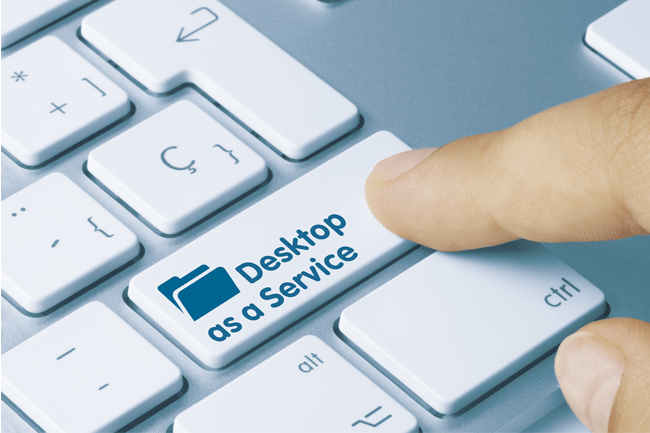
REMOTE OFFICE | 5 MIN READ
When businesses plan for a transition to a remote environment, many think about how to properly configure VPN's and office phones. However, what about desktops? At some companies, not every employee has a desktop, which can mean that in the event of a temporary or even permanent transition to a remote office, the cost to suddenly buy a large amount of desktops can quickly add up. Additionally, some employees may want to flexibility to work from devices besides their work desktop. Keep reading to learn how Desktop-as-a-Service (DaaS) can help you ease the transition of workstations to a remote environment.
Not enough time? Jump to:
Benefits of Desktop-as-a-Service
Other Ways to Enable a Remote Work Environment
What is Desktop-as-a-Service?
Desktop-as-a-Service (DaaS) leases virtual desktops via a public or private cloud service. Virtual desktops allow for an individual to transform a personal device such as a laptop or tablet into a work desktop and access all the applications and files that are on their work computer.
The backend virtual desktop infrastructure (VDI) infrastructure and virtual "machines" that run the virtual desktop operating systems are all hosted by a third-party cloud provider. Your DaaS provider handles the security, functionality, and maintenance of your virtual desktops.
All that your business needs is an Internet connection and some software to access a virtual desktop.
For businesses looking to temporarily go remote or for those that don’t want to invest in and manage their own on-premises VDI solution, DaaS handles the nitty gritty details, allowing you to focus on the important aspects of your remote transition.
Virtual desktops save businesses the money they would have spent on physical desktops in a remote transition by allowing employees to work from personal devices.
Besides setting your business up with desktops, DaaS providers can also supply software, also known as Software-as-a-Service, and virtual desktops. This multi-faceted offering is a turnkey solution that simplifies the remote transitioning process.
DaaS usually bills in a flat rate spread over the period of the lease, which gives businesses the flexibility to quickly go remote while simplifying budgeting.
RELATED: How to Transition to a Remote Office
Benefits of Desktop-as-a-Service

Flexibility
DaaS gives offices the flexibility to quickly go remote while allowing employees the flexibility to work whenever and wherever they want on the devices they prefer by simply accessing the virtual desktop.
Ensuring the security of your network, laying out a remote office management plan, and buying the proper hardware and software can quickly become stressful. When your DaaS provider sets up employee workstations and downloads necessary software for your network, this eases your company's burden, allowing for a smoother and faster remote transition.
Business Continuity
Virtual desktop services allow your business to quickly pivot to remote operations in the event of a network outage. Since virtual desktop data is stored in the cloud, data loss will be minimal and employees can quickly begin working from personal devices at home.
One way in which DaaS providers minimize downtime is through geo-redundancy. This is the process of replicating servers and data across multiple data center locations so that business operations may continue even if one data center location goes down.
Management and Security
Your DaaS provider handles the maintenance and security of your virtual desktops, which means your organization can focus on more business-critical tasks.
A fleet of virtual desktops can easily be managed all at once by your DaaS provider, allowing them to make changes company-wide at one time instead of making changes one at a time to individual computers.
In terms of security, the way data storage works with virtual laptops can end up being superior to data stored in a third-party data center. With virtual desktops, if an employee's personal device is stolen, no company data is lost, as data is stored on the virtual desktop instead of the physical desktop.
Cost and Budgeting
If companies were to outright purchase desktops before a switch to a remote environment, many wouldn't have the capital to afford it up front.
DaaS lets employees transform personal devices into work desktops, which means that you don't have to worry about cobbling together capital you might not have to purchase desktops for your remote employees.
Since DaaS pricing tends to come in a flat monthly rate, budgeting is simplified as opposed to flexible pricing models. Additional money is saved by only paying for DaaS for as long as you stay remote.
Productivity
With DaaS, all your employees need is an Internet connection and their computer to access their work any place at any time. This enables them to work on projects outside of business hours, which is beneficial to those who are naturally more productive at different times of the day.
Additionally, because the computing power for virtual desktops comes from a data center, thin clients can be utilized for the remote workplace. This means that employees whose work requires high computing power can still work efficiently using a personal device with lower computing power.
Other Ways to Enable a Remote Work Environment

Set Up VPN's
VPN's, also known as Virtual Private Networks, can be used in conjunction with public or home WiFi to ensure that data is encrypted when being sent along a public Internet signal to and from your office's network.
VPN's authenticate your information with your network's firewall before allowing it through, which ensures that information is encrypted and your network is still secure when all employees are sending information, logging into programs, and communicating with each other.
Even if employees aren't handling sensitive data, it is a good rule of thumb to ask everyone to always sign into a VPN before going to work online remotely.
Make sure that every employee has a VPN installed and set up on their computers before taking your office remote. Your network should already have a corporate VPN, so you can set your office up on that and make sure that everyone is trained on how to use it.
Configuring VPN's for all employees is arguably the most crucial step in setting up your office to go remote because it ensures that your network is still secure even when everyone is out of the office.
Without a VPN, hackers could access sensitive information that employees are sending to each other over public WiFi.
RELATED: What is a VPN?
Set Up a Business Continuity Disaster Recovery Plan
If your company doesn't have a BCDR (Business Continuity Disaster Recovery) plan, consider setting up at least the foundations of one before taking your office remote.
Network outages and ransomware attacks can happen even when your office is remote, so ensure that your business can avoid lengthy downtime by taking a few simple steps.
Make sure that your business' data is automatically backed up as often as possible. In the event of a network outage or ransomware attack, you may have to restore all devices to the most recent backup. If you don't back up data frequently, you risk losing access to important documents.
Additionally, make sure that all executives and any in-house IT staff know the proper steps to take in the event that your network is breached or stops working. This will minimize downtime and ensure that everybody is on the same page.
RELATED: What Is Phishing? [Types and Tips to Prevent]
Update/Patch Necessary Cyber Security Software
Before taking your network remote, audit all computers within it to ensure that all antivirus and anti-malware are working properly. Make sure that all antivirus and anti-malware are running the latest version so that all security gaps are patched.
Additionally, if you want to be really thorough in an examination of your network, check that all computers on your network are free of any security gaps.
Set Up Remote Communication Platforms
If employees will be working remotely, they may need more communication channels than just email. Consider which additional communications platforms that you wish to implement.
If you have a unified communications platform, you may already have services such as instant messaging and virtual conferencing bundled in. Check to see if you have any of these platforms before looking at buying/leasing a new software.
For instance, Elevate includes virtual conferencing platform AnyMeeting with all unified communications packages.
If you wish to set up instant messaging platforms, consider Slack or Microsoft Teams. If you already have Office365 set up, all your employees should be able to access Teams.
Planning for remote meetings may become a little tricky, but by setting up virtual conferencing platforms, you and your employees will be able to have phone and video conferences.
Consider platforms such as Zoom for virtual conferencing. As long as employees have a fairly strong Internet signal, conferencing should be able to take place with minimal issues.
When you're planning for remote conferences, you also need to consider whether or not you wish to purchase headsets or microphones for employees to enhance the sound quality during meetings.
Also, if you want employees to be able to call each other while away from their desk phones, figure out if they will be using personal phones for communication and if so, what that will look like.
RELATED: Remote Conferencing Security: How to Find the Right Provider
Set Up Secure File Sharing
Remote working doesn't halt the sharing of private documents and sensitive information. Setting up secure file-sharing platforms ensures that business continues to flow smoothly and securely.
Platforms such as OneDrive or ShareSync let you open and view your synced files directly from your phone and share files with co-workers and clients.
Keep in mind that if you have a Managed Service Provider, you may already have a secure file-sharing service bundled into your cyber security package, which will save you the cost of having to buy one of these platforms.
Conduct a Remote Test Run
Before taking your entire company remote, consider conducting a test run to address any issues that pop up. Ask a few employees to work remotely from home for a few hours and monitor them.
Make sure that they can log into their computers and programs, and that their connections are secure. Check to make sure that there are no security gaps that pop up.
Make sure that your network will not be overloaded by a massive influx of remote workers accessing the network, and if it will be overloaded, make necessary adjustments.
Additionally, test your Business Continuity Disaster Recovery plan at this time to ensure that all steps would unfold smoothly in the event of a network outage or ransomware attack.
RELATED: Remote Office Management: 4 Key Tips
As a DaaS provider and a managed service provider (MSP), Standard Office Systems aims to use our cyber security knowledge and resources to educate the public about how to safely and efficiently secure their networks, especially for remote offices.
Here at Standard Office Systems, we help our clients make a seamless transition to remote work by mapping out the strategic and technical steps that must be taken.
We hope this article answered some of your questions. For more IT-related content, follow our blog!
RELATED: What are Managed IT Services?
Posted by Andre Schafer

Andre Schafer is a Technical Account Manager at Standard Office Systems. He has spent his entire career in the Office Technology and IT fields. For nearly 30 years, he has held various roles, including Technician, Trainer, Analyst, and Account Manager. Andre’s focus has always been to understand his customers' business needs to provide the appropriate technologies and services.

